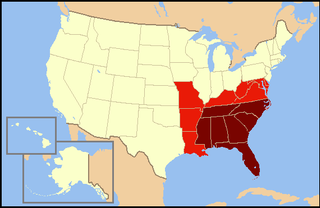
A wildflower is a flower that grows in the wild, meaning it was not intentionally seeded or planted. Yet "wildflower" meadows of a few mixed species are sold in seed packets. The term implies that the plant probably is neither a hybrid nor a selected cultivar that is in any way different from the way it appears in the wild as a native plant, even if it is growing where it would not naturally. The term can refer to the flowering plant as a whole, even when not in bloom, and not just the flower.
The Mizzou Botanic Garden contains thousands of plants within the campus of the University of Missouri in Columbia, Missouri, United States. The Garden includes famous icons, such as Thomas Jefferson's original grave marker and the Columns of Academic Hall, and is open year-round, only asking for a small donation to visit.
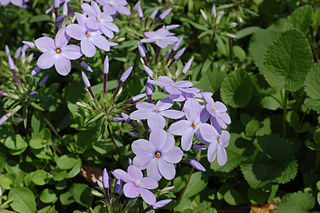
Phlox stolonifera is an herbaceous, stoloniferous, perennial, plant that is native to woodlands in the vicinity of the Appalachian Mountains from Pennsylvania south to northern Georgia in the United States. Naturalized populations occur as far north as Québec, Canada.
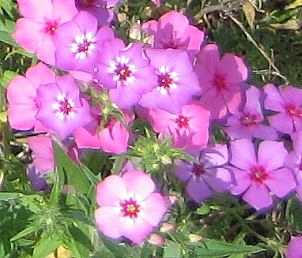
Phlox drummondii is a flowering plant in the genus Phlox of the family Polemoniaceae. Native to Texas, it is also widely distributed in the southeastern United States, especially along public highways. P. drummondii is often used as an ornamental plant. The flowers have a wide range of colours "from white and cream through pinks, lilacs, roses, purples and reds, to almost black".

Phlox alyssifolia, the alyssum-leaved phlox, is a flowering plant in the genus Phlox. It is native to central North America.
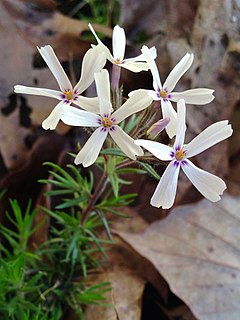
Phlox subulata is a species of flowering plant in the family Polemoniaceae, native to eastern and central USA, and widely cultivated. Growing to about 13 cm high at most and covering a 50 cm (20 in) wide area, it is an evergreen perennial forming mats or cushions of hairy, linear leaves. The small, five-petaled flowers bloom in rose, mauve, blue, white, or pink in late spring to early summer.
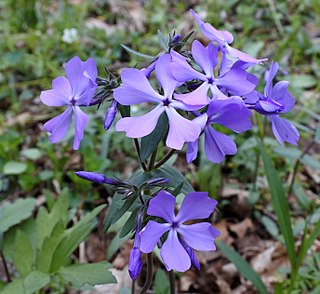
Phlox divaricata, the wild blue phlox, woodland phlox, or wild sweet william, is a species of flowering plant in the family Polemoniaceae, native to forests and fields in eastern North America.

Phlox paniculata is a species of flowering plant in the family Polemoniaceae, native to the eastern and central United States and eastern Canada. It is extensively cultivated in many lands as an ornamental plant and has become established in the wild in scattered locales in other regions.

Phlox hirsuta, the Yreka phlox or hairy phlox, is a species of phlox. It is a small flowering plant that grows in the serpentine soils of Siskiyou County, California and is the official city flower of Yreka, California, after which it is named.
Navarretia tagetina is a species of flowering plant in the phlox family known by the common names marigold pincushionplant and marigold navarretia. It is native to the western United States from Washington to central California, where it grows in wet grassland habitat such as vernal pools. It is a somewhat hairy annual herb growing up to about 30 centimeters tall. The leaves are deeply divided into many spreading needlelike lobes. The inflorescence is a cluster of many flowers surrounded by leaflike bracts. The flowers are pale blue and about a centimeter long.

Phlox diffusa is a species of phlox known by the common name spreading phlox. It is native to western North America from British Columbia to the southwestern United States to the Dakotas, where it grows in many types of habitat, including rocky, high elevation mountain slopes. It is a very compact mat-forming perennial herb growing in cushions or patches of short, decumbent stems. The linear, lance-shaped, or needle-like leaves are no more than 1.5 centimeters long and are oppositely arranged in bundles on the short stems. The inflorescence is a solitary tubular flower around a centimeter long. It has a flat white or pale pink or blue corolla with five lobes each just under a centimeter in length.

Microsteris is a monotypic genus of flowering plants in the phlox family containing the single species Microsteris gracilis, known by the common name slender phlox.
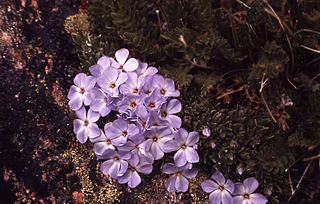
Phlox pulvinata is a species of phlox known by the common name cushion phlox. It is native to the western United States where it grows in mountain and plateau habitat, in rocky subalpine and alpine climates, including exposed tundra habitat. It is a perennial herb taking a flat, dense, cushionlike form on the ground. Its very short stems are lined with hair-fringed lance-shaped leaves each no more than one centimeter long. The plant is among the first to flower in the spring in many areas. It blooms densely, forming carpets of flowers. Each white to pale pink flower has a tubular throat up to one centimeter long and a flat five-lobed corolla.

Phlox speciosa is a species of phlox known by the common name showy phlox. It is native to western North America from British Columbia to Arizona and New Mexico, where it occurs in sagebrush, pine woodlands, and mountain forests. It is an erect perennial herb with a shrubby base growing up to about 40 centimeters tall. The leaves are linear or lance-shaped, oppositely arranged, and generally glandular. The inflorescence bears one or more white to pink flowers with elongated tubular throats each up to about 1.5 centimeters long. The corolla has five double-lobed, notched, or heart-shaped lobes.
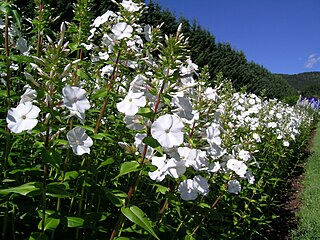
Phlox carolina, the thickleaf phlox, is a species of flowering plant in the family Polemoniaceae. It is an herbaceous perennial growing to 1.2 m (4 ft) tall by 45 cm (18 in) wide, with leaves to 13 cm (5 in) long, and purple or pink flowers in summer. The specific epithet carolina refers to its native habitat in the eastern United States.

Phlox bifida, the cleft phlox or sand phlox, is native to the Midwestern United States, the Ozarks, and the cedar glades of Kentucky and Tennessee. It is found on rock outcrops, limestone glades, and in generally dry or sandy areas.
Phlox buckleyi, common name swordleaf phlox or shale-barren phlox, is a plant species native to Virginia and West Virginia. It grows in open woodlands, primarily on hillsides derived from shale. The first known specimen was first collected in 1838 but not described as a species until 1930.


